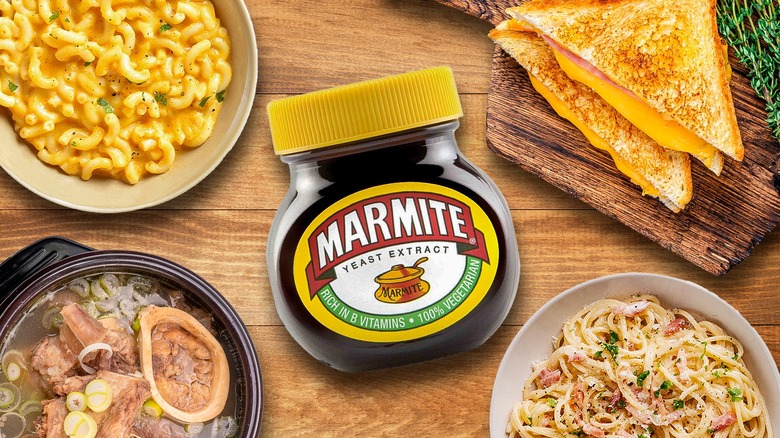Marmite Ingredients: Everything You Need to Know About the Iconic UK Spread

Marmite ingredients have long fascinated both fans and skeptics of this iconic UK spread. Loved by some and strongly disliked by others, Marmite is known for its intensely savoury taste, a flavour that divides opinions and sparks curiosity. Understanding what goes into Marmite helps people appreciate its nutritional value and versatility, whether eaten traditionally on toast or incorporated into creative recipes.
The origins of Marmite are equally interesting. Originally created as a by-product of beer brewing, Marmite has evolved into a beloved British staple. Its combination of yeast extract, vitamins, salt, and natural flavourings forms the backbone of Marmite ingredients, creating a spread that is both nutritionally dense and rich in umami flavour. Over the decades, Marmite has become more than just a breakfast spread—it is a cultural phenomenon.
What Is Marmite Made Of?
The primary component of Marmite is yeast extract, a thick paste produced from the yeast used in brewing beer. Yeast extract is rich in naturally occurring B vitamins, which are vital for energy metabolism, brain function, and healthy nerves. This ingredient provides the distinctive, umami-rich flavour that has made Marmite ingredients so recognisable and unique.
Alongside yeast extract, Marmite contains salt, vegetable juice concentrate, and natural flavourings such as celery and other spices. Vitamins including thiamin, riboflavin, niacin, folic acid, and B12 are added to fortify the spread. Regional variations, like the New Zealand version, may also include corn maltodextrin, caramel colour, iron, and added herbs or spices, highlighting how Marmite ingredients can differ around the world.
Marmite Nutrition and Health Facts
Marmite ingredients contribute to a surprisingly nutritious profile despite the spread’s strong flavour. It is exceptionally rich in B vitamins, which play a crucial role in energy production, supporting the nervous system and maintaining overall health. A small serving of Marmite can provide a significant portion of your daily vitamin B intake, making it a convenient way to supplement a balanced diet.
While Marmite is high in salt, it is low in calories and fat, which makes it a popular choice for those seeking flavour without extra calories. For vegans and individuals with dietary restrictions, it’s important to note that Marmite ingredients include gluten from barley, wheat, oats, and rye, which may be a concern for people with celiac disease or gluten sensitivity. However, the UK version is suitable for vegans, adding to its appeal.
Marmite in Popular Food and Recipes

Marmite ingredients shine when used creatively beyond the breakfast table. Marmite roast potatoes are a beloved twist on a classic dish, while Marmite pasta and Marmite rice cakes showcase the spread’s versatility in modern cooking. These recipes demonstrate that Marmite’s unique flavour can elevate a variety of meals, adding depth and savouriness that few other condiments can match.
Novelty products such as Marmite peanut butter, Marmite cheese, and Marmite crisps highlight how Marmite ingredients can adapt to innovative culinary creations. Each of these products retains the core taste derived from yeast extract and natural flavourings, allowing fans to enjoy Marmite in exciting new forms. This experimentation keeps the brand relevant and constantly evolving in the market.
Fun Facts and Trivia About Marmite
Marmite has a fascinating history full of quirky marketing and memorable campaigns. Personalised Marmite jars have become a popular gift across the UK, while celebrity endorsements, including Elton John Marmite promotions, have added to the spread’s iconic cultural status. These campaigns illustrate how Marmite ingredients have transcended food to become a pop culture symbol.
Over the years, Marmite ingredients have been used in numerous experimental products, some of which were eventually discontinued. These innovations show the brand’s willingness to explore new flavour combinations while staying true to the classic yeast extract base. Marmite’s enduring popularity is a testament to its distinctive taste, memorable branding, and culinary versatility.
Marmite and Pets
Pet owners often wonder whether Marmite is safe for dogs. Small amounts of Marmite can be given occasionally, as the B vitamins present in Marmite ingredients may offer some nutritional benefits. However, due to its high salt content, overfeeding Marmite can be harmful to pets, potentially leading to health complications such as dehydration or high blood pressure.
Consulting a veterinarian before introducing Marmite into a pet’s diet is essential. Understanding Marmite ingredients allows owners to make informed decisions about treating their pets safely. While humans enjoy the spread for its flavour and nutritional content, moderation is crucial to ensure it remains a safe and occasional indulgence for dogs.
Marmite vs Vegemite
Marmite ingredients are often compared with those of Vegemite, an Australian yeast extract spread. Both spreads share yeast extract as their base, but Marmite has a saltier, stronger flavour, while Vegemite tends to be milder. Understanding these ingredient differences helps consumers appreciate the unique qualities of each product and why taste preferences can be so polarising.
Nutritionally, Marmite ingredients offer higher concentrations of certain vitamins compared to Vegemite, making it a more potent source of B vitamins. Both spreads are versatile, and their distinct flavours suit different recipes and palates. Knowledge of Marmite ingredients empowers consumers to make informed choices about which spread to incorporate into their diets or culinary experiments.
Conclusion
Marmite ingredients are far more than a simple list of components—they are a combination of nutrition, taste, and cultural history. From yeast extract to added vitamins and natural flavourings, each element contributes to Marmite’s iconic flavour, making it a staple in UK households and beyond. Its unique taste continues to divide opinions while delighting fans worldwide.
Exploring Marmite ingredients also opens the door to creative cooking and informed dietary choices. Whether used traditionally on toast, in innovative recipes, or as part of novelty products, Marmite remains an iconic spread with a rich heritage. Understanding its ingredients allows everyone to appreciate the full story behind this much-loved British food.
You may also read: Tim Spector 30 Plants a Week List: Complete Checklist to Boost Gut Health
